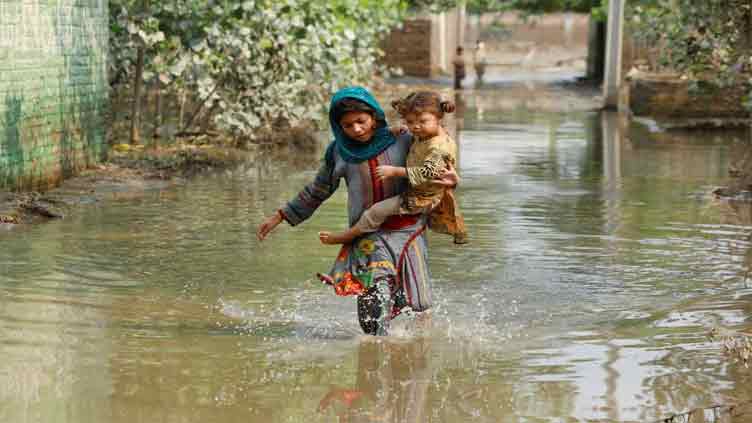Thunderstorms, rain continue lashing several parts of Pakistan

Pakistan
Kasur receives 125mm of rain
LAHORE (Web Desk) – Heavy downpour and thunderstorm lashed different parts of Pakistan late Friday night and Saturday morning as the ongoing monsoon spell continues affecting the country, with the highest amount of rain 125mm recorded in Kasur (Punjab).
According to the morning bulletin of Pakistan Metrological Department (PMD), rain and thundershowers with isolated heavy falls were reported from Khyber Pakhtunkhwa, Punjab, Islamabad, Kashmir, Gilgit-Baltistan, north Balochistan and lower Sindh.
In Balochistan, Sibbi, 78mm, received the highest amount rain followed by Chhor (Sindh) 57mm, Rawalakot (Kashmir) 39mm, Hunza (Gilgit-Baltistan) 20mm and Kakul (Khyber Pakhtunkhwa) 09mm during the past 24 hours [till 8am].
Read more: PM Shehbaz says least developed countries adversely affected by climate change
As far as Lahore is concerned, thunderstorm hit different parts of the city before sunrise as rain was continuing by the time this report filed around 3pm with the heaviest rainfall recorded in areas like Nishtar Town, Johar Town, Lakshmi Chowk and Gulshan-e-Ravi.
Meanwhile, at least nine people were injured in two separate incidents of roof collapse in Azhar Town and Shahdara Town areas of the city.
The Met Office has warned that heavy rain may generate urban flooding in the low-lying areas of Gujranwala, Lahore, Sialkot, Sahiwal, Multan, Bahawalpur, Bahawalnagar and Okara till Sunday (June 8).
Similarly, there is a threat of triggering landslide in the mountainous areas of Murree, Galliyat, Kashmir, Gilgit-Baltistan and Khyber Pakhtunkhwa and of flash floods in Kashmir, DG Khan, Kohlu, Sibbi, Barkhan, Zhob, Loralai, Qilla Saifullah and Musa Khel during the same period.
In this connection, Minister for Climate Change Sherry Rehman in a tweet noted the prediction about the heavy rainfall on Sunday, especially in upper/northeastern Punjab and Kashmir, while calling enhanced preparedness.
Heavy rains and associated risks predicted for the weekend in Lahore and other cities in Punjab. @ndmapk has been providing regular early warnings to PDMAs and all stakeholders. Please enhance preparedness pic.twitter.com/xDLEkBl6bB
— SenatorSherryRehman (@sherryrehman) July 7, 2023
The reason behind persistent rainfall and cooler temperature, especially in upper/central Punjab and Kashmir, a westerly is combining with the monsoon currents from the Bay of Bengal penetrating the country.
However, the temperature is still high in most parts of Balochistan and upper/central Sindh with Turbat 44 degree Celsius being the hottest place in Pakistan during the past 24 hours followed by 42 Celsius in Shaheed Benazirabad and Sibbi.
Officials on Friday said that at least 50 people, including eight children, had been killed by floods and landslides triggered by monsoon rains that have lashed Pakistan since June 25, AFP reported.
The summer monsoon brings South Asia 70-80 per cent of its annual rainfall between June and September every year.
Read more: Rice to get costlier as weather, India's farm perks threaten supply
It is vital for the livelihoods of millions of farmers and food security in a region of around two billion people -- but it also brings landslides and floods.
"Fifty deaths have been reported in different rain-related incidents all over Pakistan since the start of the monsoon on June 25," a national disaster management official told AFP, adding that 87 people were injured during this period.
The majority of the deaths were in eastern Punjab province, and were mainly due to electrocution and building collapses, official data showed.
Scientists have said climate change is making seasonal rains heavier and more unpredictable. Last summer, unprecedented monsoon rains put a third of Pakistan under water, damaging two million homes and killing more than 1,700 people.
Storms killed at least 27 people, including eight children, in the country's northwest early last month.
Read more: Inflation and interest rates: El Nino will brew up potent new economic storm
Pakistan, which has the world's fifth largest population, is responsible for less than 1pc of global greenhouse gas emissions, according to officials.
Read more: Climate nears point of no return as land, sea temperatures break records, experts say
The scale of climate change can be gauged by the fact that Italy's available water resources hit an all-time low in 2022, as a combination of rising temperatures and lower rainfall halved fresh supplies compared to the average of the last 30 years,data showed on Friday.
Read more: Climate change: Italy's water resources hit rock bottom in 2022
A drought last year also disrupted Italian olive oil output, which fell to its lowest level since 1990, said ISTAT, the national statistics institute.

